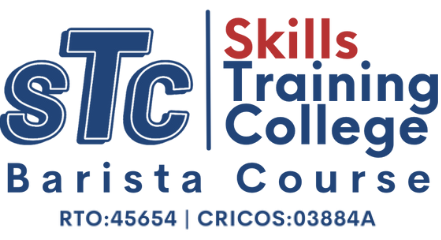The variables of extracting flavour from ground coffee and their impact on different brewing methods

This article has been reviewed for accuracy by Dr. Richard Muhlack, Senior Lecturer at the University of Adelaide’s School of Agriculture, Food, and Wine.
In a previous article, we examined the complexity of extracting coffee flavour and why the process was so dynamic and variable – particularly focussing on the impact of grind size and the relative release rates of different types of flavour compounds in the ground coffee particles. One piece of feedback we received on that article was that it focussed particularly on one mechanistic aspect of the coffee extraction process – namely, grind size and the consistency (or inconsistency) of the particles.
As such, it was worth taking a more broad look at many of the variables which can impact the coffee extraction process.
Unfortunately, the impact these variables have on the coffee extraction process can be more or less significant depending on the brewing method. For example, for an immersion method such as French press coffee (also known as plunger coffee), pressure is not a significant variable – the pressure in a coffee plunger is roughly equal to the ambient atmospheric pressure (generally around 14.7 psi or approximately 1 bar). This means timing is a far more critical variable for flavour extraction with a coffee plunger. By contrast, espresso (an infusion/percolation method of brewing) uses pressurised water forced through the coffee bed, which makes pressure far more of a significant variable.
As such, we will examine not only the main factors impacting the extraction process but also their significance for different brewing methods.
Factors that affect coffee extraction
There are a vast number of factors that influence the final taste of a cup of brewed coffee, such that even the very best methods we have for modelling these processes work off broad generalisations. For example, the specific geometry (and thus surface area) of individual coffee granules and the size and shape of each coffee cell within the structure are incredibly difficult to measure or precisely model [1].
As such, most models assume coffee granules are spherical, and coffee cells are consistent in size and shape.
Likewise, Darcy’s law, which is used to calculate the flow of fluid through a resistant medium [2] (we’ll discuss this later) takes little account of complex dynamics such as hot water forming channels through a bed of ground coffee and simplifies this down to one variable – the permeability (or resistance) of the medium.
This is largely a matter of practical necessity, as the calculations of 2000 flavour compounds extracting from randomly sized granules in a medium of highly variable density are probably more in the realm of chaos mathematics.
However, even though the science of coffee brewing depends on many generalisations, we can still understand what variables contribute to the process and empirically test their impact, which can give us a good practical grounding in what is needed for a good cup of coffee. In fact, this is similar to how Darcy’s law was originally derived – through practical experimentation rather than being deduced directly from physics principles.
As such, it’s worth looking at some of the most significant variables affecting the coffee brewing process.
Temperature of the water
One of the first factors to come into play is the temperature of the water. Water temperature plays a critical role in coffee extraction and greatly affects the times required for optimal flavour extraction. Even relatively similar brewing methods, such as French press or plunger coffee and cold brew coffee, require vastly different times to brew – around 4 minutes in the case of French press and around 18-24 hours in the case of cold brew.
In physical chemistry, this is shown by the Arrhenius equation [3], which describes how a certain amount of activation energy is needed for a chemical reaction to initiate. In brewing coffee, the heat of the near-boiled water provides the necessary energy relatively quickly, meaning the process of extracting the flavour occurs rapidly. However, the process is not quite as simple as “more heat = quicker, less heat = slower”.
As discussed in a previous article, coffee contains a range of different flavour compounds which do not all extract at the same rate. In particular, the first compounds to be extracted tend to be sour flavours (and caffeine, which is extracted early in the process), followed by the sweeter “balancing” flavours (including sugars and volatile oils), and lastly, the more bitter, astringent flavours that dry the mouth. As the graph below shows, these have different release rates, which peak at different times.
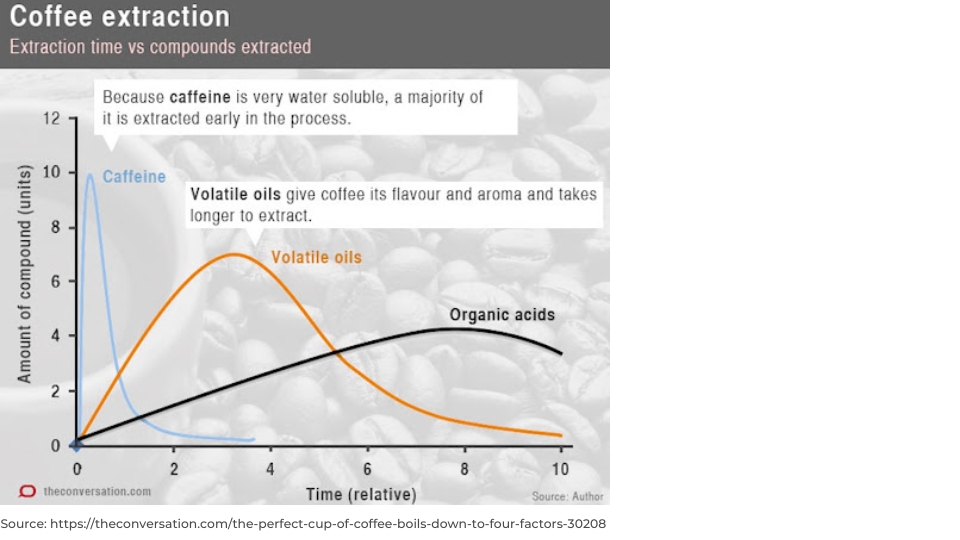
All of these rates are affected by temperature, but not to the same degree – caffeine is moderately affected, while the bitter, late-extraction compounds tend to be more strongly affected [4]. This means, for example, that cold brew coffee has a very wide margin for error when it comes to minimising bitterness – and an appropriate reputation for being less bitter [5]. By contrast, hot coffee is normally extracted in a matter of minutes, so the margin for error is narrower – a minute or two rather than several hours.
In addition, the coffee industry’s strong consensus is that optimal hot water brewing should be done at around 90°C – 96°C rather than at boiling temperature. The reason for this is that at 100°C, it is very difficult to prevent the release of the later bitter flavour compounds – the release of the sweet and bitter flavours overlap far more than at slightly lower temperatures.
According to the Arrhenius equation, an increase in temperature of 10°C approximately doubles the rate of most chemical reactions, as well as accelerating physical processes – including the speed at which compounds dissolve into water. So using water at boiling point (100°C) greatly increases the initial rate at which coffee flavour is extracted compared to water at 90°C.
In addition to this, many desirable compounds are entirely removed from the coffee by using water at temperatures close to boiling point. Many of the more desirable sweet and balancing flavours in coffee are provided by what’s known as the volatile oils – so named because they’re far less chemically stable and prone to degrade or evaporate. When water at temperatures near boiling point is used for brewing, a considerable amount of steam is released. Many of the more volatile flavour and aroma compounds are carried away with the steam. This can produce coffee that has both the early-release sour compounds and the later bitter flavours, but where the sweeter, balancing compounds are largely absent – making it bitter and sour at the same time.
So while many home users unthinkingly pour water from their kettle into their coffee plunger immediately after boiling, the prevailing wisdom within the coffee industry is that this will produce a less desirable cup of coffee. Even if you like your coffee hot, it’s best to wait 30-60 seconds until steam evaporation has allowed the water to cool down by 5 – 10°C before starting the extraction process.
Brewing pressure
Another factor that plays into the speed of coffee extraction is pressure. Like temperature, high pressure applies more activation energy to the coffee and speeds up the process. Although in this case, the energy in the water is technically being concentrated into a smaller area rather than increased.

Many methods of coffee brewing don’t take any particular account of pressure. Or, more precisely, they assume the pressure is a constant – the pressure of the atmosphere around them (which is normally slightly over 1 bar of pressure, or around 14.7 psi). In particular, immersion brewing methods (which we’ll discuss later) make little use of pressure. However, some brew methods – notably the Moka pot, the Aeropress, and particularly the espresso machine – use pressure to push water through the ground coffee beans and speed the extraction process. This pressure is why espresso is normally extracted in 20-30 seconds rather than the minutes required for methods like French press drip filter coffee.
As such, we’ll address the impact of pressure in more detail when we specifically discuss immersion brewing.
Time the water is exposed to the coffee
This is a big factor in the results of brewing coffee and plays an important role in every method of coffee brewing. As discussed previously, the extraction of coffee flavour from the ground beans is a dynamic process with around 2000 different flavour compounds being extracted [6] at various different rates. One of the central aims of most coffee brewing methods is to extract the beneficial early and middle flavour compounds (particularly the sweeter middle compounds which balance the earlier flavours), but avoid the bitter, astringent flavours released later in the process.
Unfortunately, this is easier said than done, with so many of the variables of brewing affecting the speed that coffee flavours extract. Effectively, the optimal brewing time is not only highly specific to each brewing method, but can also be altered by countless other factors. But it does remain one of the most controllable factors of the brewing process – and is thus a significant focus for many coffee brewing methods.
Coarseness of coffee particles
As established in our earlier article, the size of the coffee granules plays a large factor in not only the speed at which coffee flavour is extracted from the granules, but also the balance of flavour in the overall product. And as with temperature, it’s not simply a question of smaller granules making for quicker extraction. In particular, coffee grinds that contain highly varied granule sizes are particularly hard to extract consistent flavour from, as the different-sized granules extract at different rates.

All coffee grinds that have not been specifically filtered for granule size contain what are known as boulders and fines. Boulders are the larger chunks of coffee bean broken apart by the grinder and typically range from an average of around 1mm (1,000 μm) in diameter or larger for coarse grinds, down to around 0.2mm – 0.3mm (200 – 300 μm) for fine grinds. Fines are generally the “shrapnel” thrown out by the grinding process and are generally less than 100 μm / 0.1mm in size. However, large quantities of fines or a wide spread of granule sizes (both of which can be caused by lower-quality grinders) can mean coffee extracts at varying rates. This can mean a very inconsistent coffee flavour, with bitter flavours extracted from the smaller granules and an over-abundance of early extracted sour flavours [7].
Regardless of the brewing method, the best brewing results generally come from a more consistent grind – where the boulders are a reasonably consistent size, and the number of fines is minimal – which generally requires a good quality grinder. It’s also worth remembering that larger coffee granules can also make the extraction process more complex – as the water gradually permeates through the granules, extracting flavour from different layers at different intervals.
Distribution of coffee particles
Another factor, often strongly influenced by the coarseness of the grind, is how the coffee particles are distributed throughout the coffee.
In some brewing methods (particularly immersion-based ones) this is less significant – particularly in immersion methods. In a French press, for example, the water is poured in with the coffee and allowed to mix freely. However, in some immersion methods (such as Turkish coffee), it is possible to get clumps of tightly packed coffee granules where the flavour isn’t so well extracted [8]. And in infusion methods where the water is forced through a bed of ground coffee, the distribution has a massive impact on the final flavour. This means that how the bed of coffee is packed and, in some cases, agitated plays a significant role in final extraction.
The two main potential issues with the distribution of coffee particles are clumping and channelling. Clumping is when a portion of the ground coffee is packed together so tightly that the water does not permeate inside – meaning portions of the coffee are wasted. It also means that in situations where the dose of coffee is carefully measured (such as espresso), the brew might be weak – with too little coffee for the amount of water.
Channelling is a more extreme version of the same problem, where the entire bed is so tightly packed that water cannot easily permeate through the bed. In these cases, the water can potentially carve a channel through the coffee bed rather than soaking through. This will mean the ground coffee around the channel is over-extracted (as most of the water travels through this region), while the majority of the ground coffee is not extracted at all – generally resulting in a coffee that is both weak and bitter.
Although finer grinds are one way to counteract the inconsistent extraction seen with a mixture of coffee particle sizes, finer grinds run an increased chance of clumping and channelling as the smaller particles pack together more tightly.
The coffee-to-water ratio
One of the most easily modified variables for most brewing methods is the ratio of water to ground coffee used. It is also one of the most subjective, as the primary impact it has on the final brew is to modify the TDS (total dissolved solids), which measures the amount of coffee matter dissolved in the water, or how “strong” the coffee is. Brew strength is very much a matter of personal choice, with some preferring the strength of a standard filter coffee [9] (with around 1.3% to 1.45% of the drink made up of coffee solids), and others preferring a straight “Short Black” shot of espresso, at a TDS of around 7% – 12%.
To complicate things further, each coffee brewing method has its own optimal ratio of water to coffee. Espresso (which is typically highly concentrated) often works with a coffee-to-water ratio of around 1:2. Plunger coffee, however, uses much more water – a ratio of generally around 1:15.
If a particular brewing method uses too little water, the resulting brew will have a very high TDS and quite likely a very strong flavour. If the dose (the amount of coffee) is too small or too much water is used, the resulting brew will likely be thin and watery with a very low TDS. Of course, given one or the other, too strong is generally regarded as preferable – it’s relatively easy to add more water to coffee but nearly impossible to take it out again.
For most brewing methods, the coffee-to-water ratio acts as a very simple way to govern the strength of the coffee – making it one of the most useful variables for coffee brewers. However, it’s also one of the first things coffee brewers need to get right.
Freshness of the Roast (Degassing)
One of the less well-known factors of coffee brewing is that roasted beans have an optimal window for use. The primary reason for this is the release of carbon dioxide.
During the roasting process, CO2 is released from the structure of the bean. This is most evident when beans are roasted to the level of a dark roast and go through what’s known as “Second Crack” – when the structure of the bean cracks from the internal CO2 pressure, allowing the gas to leak out. But whether the bean has gone through second crack or not, CO2 has still been released into the structure of the roasted bean [10] and needs to escape.
This gas will be slowly released from the bean in the days following roasting in a process known as “Degassing”. This will continue over time, with the CO2 content of the bean slowly tapering off. However, this process has an optimal window for the best coffee flavour extraction. If too much gas is released, it can hamper the coffee extraction process – the excess CO2 can prevent the water from permeating the coffee granules and dissolving the coffee compounds. Such a coffee might have an impressive amount of crema (which is caused by CO2 [11]) when brewed as an espresso, but the flavour would be lacking.
However, some CO2 is important for brewing. If the beans continue to degas for long enough, too much CO2 is released, and the coffee beans go stale – coffee extracted from those beans will have a flatter taste with less flavour.
The degassing process can be slowed by keeping the beans in a controlled environment – with low temperature and little exposure to light or air. This is why beans are often sealed in plasticised foil bags and refrigerated – preventing exposure to heat, light or air. Under these conditions, coffee beans can stay fresh for a month or so.
Professional storage bags for roasted coffee beans often have an in-built valve on the bag – designed to let the CO2 from the beans out safely without allowing air back in to affect the beans.
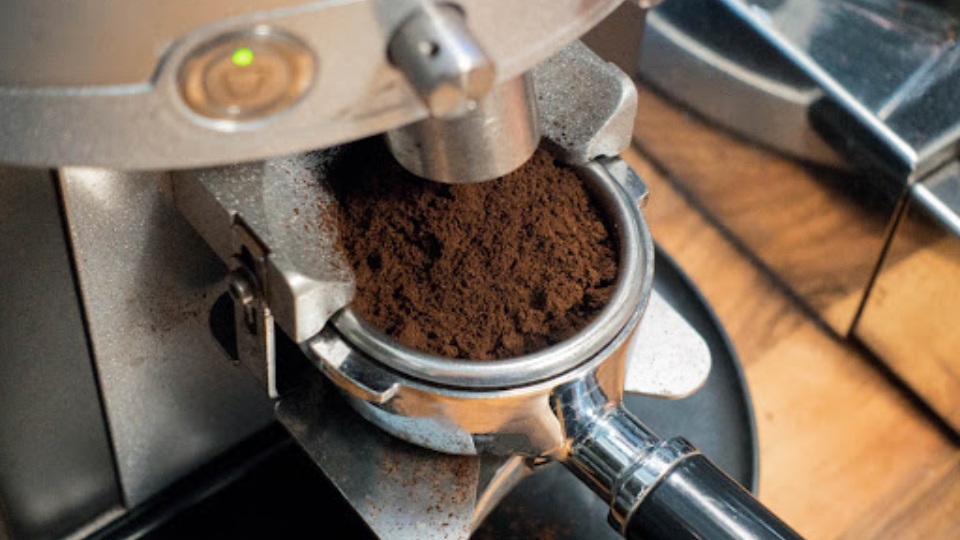
Freshness of the Grind
While the time between roasting and brewing is a significant factor in the flavour of the coffee, the time between grinding and brewing is often even more significant. Once coffee is ground, the processes through which roasted coffee goes stale are all accelerated. The reason we grind coffee is to massively increase the exposed surface area of the beans – allowing coffee extraction to occur more swiftly and easily. But once this occurs, the remaining CO2 in the beans is released very rapidly, and volatile flavour compounds can evaporate or break down. The coffee particles are also far more exposed to light, air, and moisture. This means that once ground, the flavour of the coffee begins to degrade very rapidly [12].
As with roasted coffee beans, this process can be slowed if the ground coffee is stored in a controlled environment – the general recommendation for household coffee is an airtight, opaque container kept in the freezer. But the general wisdom [13] – and the working standard in most commercial coffee contexts – is that coffee beans should be ground immediately before needed, and used within fifteen minutes of grinding at maximum.
Lesser Factors
In addition to the more significant factors above, there is a multitude of minor factors which can subtly influence the coffee extraction process. Some of these simply have a mild influence on the factors listed above, while others introduce an additional factor that influences or complicates the brewing process. For example, beans taken directly out of the deep freeze before grinding, or a french press taken out of the dishwasher while still hot could have a minor influence on the water temperature. Whereas the way coffee is poured from a boiled kettle into a pour-over coffee filter could agitate and disrupt the ground coffee, potentially causing (or preventing) clumping or channelling through the ground coffee.
Some factors may have multiple effects, some of which are less evident. So while it seems obvious that coffee beans taken directly from the deep freeze could impact the water temperature, it might also affect how the beans are ground. Frozen beans might break up in the grinder very differently from room-temperature beans (potentially causing more or fewer fines), which could significantly impact flavour extraction.
Some of the lesser factors that can subtly influence the brewing process include:
- The temperature of the beans
- The temperature of the brewing machinery
- Ambient temperature and air currents in the room (particularly for immersion brewing methods)
- How the water is introduced to the coffee (including pouring style for immersion brewing, and pre-wetting for infusion methods)
- The quality of the grinder (which impacts particle size and consistency)
- The shape and geometry of the coffee granules
- The viscosity of the water (this can change in some instances)
- The mineral content, or “hardness” of the water
- The roast level of the coffee beans
- The variety of the coffee beans
- How the coffee might be agitated (intentionally or accidentally)
- Whether the coffee has been “Pre-infused” with water before extraction begins
- The geometry of the filter
Of course, for many of these factors, their influence on the brewing process might be relatively small. But when several of these factors come into play, they have a discernible impact on the flavour of the coffee.
Common Brewing methods
There are a wide variety of different methods used for brewing coffee, some of which are centuries old while others have emerged only in the last decade or so. Broadly speaking, however, the majority of brewing methods fall into two broad categories – immersion methods and infusion or percolation methods.
The fundamental difference between these two is whether the ground coffee is immersed in water and allowed to steep (immersion), or whether the water flows through a bed of coffee grounds, extracting the coffee flavour compounds as it does so (infusion or percolation). To use an analogy, is the coffee taking a bath, where it sits IN the water, or a shower where the water flows over (and through) it?
It should be noted that there is some disagreement about the use of the terms immersion, infusion and percolation {https://goodcoffeeplace.com/immersion-verses-infusion-coffee-brewing/} [14]. More specifically, the term “infusion” is confusingly used for both immersion and percolation brewing. Its use within this article (as synonymous with percolation) reflects the common usage to avoid confusion. But it’s worth knowing that while the term “infusion” can be used to refer to introducing the hot water into the coffee bed (in the sense of “to introduce, as if by pouring“, the solution produced by steeping ground coffee in water is also technically referred to as an infusion, and this usage may be reflected in some reference material.

Immersion methods
Immersion brewing works by putting the coffee and water together in a common vessel, allowing the water to soak into the granules, absorb the coffee flavour compounds, and then flow back out.
As water encounters coffee granules, the extraction process occurs in two forms – erosion and diffusion. Erosion occurs when the water reaches exposed coffee solids in cells that have been broken open – either from the fines in the grind, or on the outer surface of larger granules. Erosion occurs very quickly – often in a matter of seconds. Diffusion is a slower process where the water permeates into the coffee cells deeper in each coffee granule, extracts the flavour compounds, and then flows back out. This is a natural process of physics – solids in solution will naturally flow from an area of high concentration (such as the inside of the coffee cells) to an area of lower concentration (such as the water surrounding the coffee granules) [15]. It is, however, a relatively slow process – particularly when the water is penetrating down through several layers of cells (water will normally penetrate down to around the fifth layer of coffee cells – approximately 100 μm / 0.1mm down) [9].
In many immersion methods, the heat of the water speeds up the extraction reaction, meaning it normally takes a few minutes, but this is not universal – cold brew coffee often uses room temperature or refrigerated water to extract the coffee flavour over a period of around 18-24 hours.
Brewing methods such as a coffee plunger or French press, Turkish coffee, cold brew, coffee bags, cupping, cowboy coffee, and siphon coffee are all examples of immersion brewing.
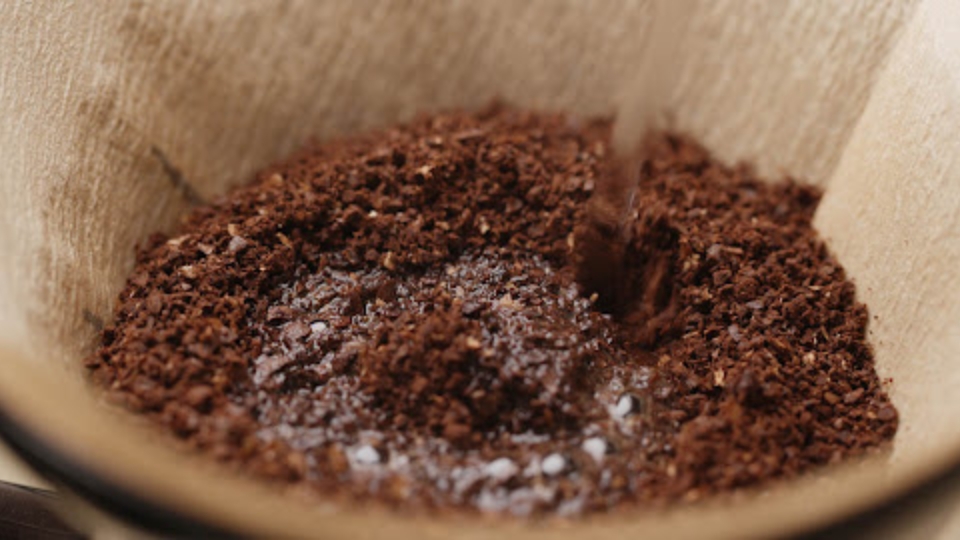
Infusion / Percolation methods
Infusion or percolation methods of coffee brewing involve water flowing through a body of ground coffee rather than the grounds being immersed in water and left to sit. Because of this, different principles come into play, and infusion brewing operates differently [16] to immersion coffee. It is also prone to different complications.
In scientific terms, the process of liquid filtering through a permeable substance (such as a bed of ground coffee) is described by an equation known as Darcy’s Law.

Unpacked a little, this equation tells us that the factors involved in the rate of water flow through a resistant medium, such as a bed of ground coffee, are as follows…
- k – How permeable the medium is (i.e. how easily water can pass through it). This is the inverse of how resistant the medium is to water flow.
- A – The surface area of the ground coffee through which the water is passing – i.e. the side-to-side width of the coffee in the filter. This can be simple, as in the case of an espresso machine (which is a cylinder) or more complex, as with the conical shape of a pour over coffee filter.
- μ – How thick the liquid is, and thus how resistant it is to being pushed through a porous medium like ground coffee (otherwise known as the dynamic viscosity of the liquid).
- L – The length of the porous medium, or in simpler terms, the depth of the bed of coffee the water is passing through.
- ρ – The density of the liquid – i.e. how heavy it is for a given volume of liquid.
- g – Is the speed at which things normally fall due to gravity (9.8 m/s, provided you’re on Earth and not trying to brew coffee on a moon base or a colony on Mars).
- h – The depth of the column of water pushing through the bed (this is combined with A to give the volume of water)
- Δp – The difference in pressure between where the water is travelling from, and where it’s going to.
All of these factors have an impact on the speed at which water flows through the coffee bed, and can thus influence the way the coffee extracts. For example, in drip filter coffee, the difference between the pressure above and below the filter (Δp) is zero – the top and bottom of the bed are both equal to normal atmospheric pressure, so the only force acting to push the water through the coffee is gravity. Whereas in espresso the difference in pressure is much higher, so the value of Δp is far more significant.
Some of these variables are influenced by several contributing factors – so the overall permeability is affected by grind size and consistency, the permeability of the coffee filter, and whether the coffee bed has already been saturated with water, among other things.
Also, Darcy’s law is mainly concerned with the rate of flow of liquid through a resistant medium, so it doesn’t describe other factors such as how effectively the coffee flavour is extracting into the water, the temperature of the water, or whether the water is soaking evenly through the coffee bed or travelling through specific channels. Thus the variables at play in Darcy’s law have an impact on the final flavour of the coffee, but there are many other factors at play.
Common methods of Infusion coffee brewing include drip filter, cold drip, pour over coffee, pod coffee, and espresso (probably the best known).
How the extraction variables interact with different brewing methods
Given the vast differences between the different coffee brewing methods used today, it’s worth examining some of the individual coffee brewing methods and looking at which brewing variables are more or less significant for each.
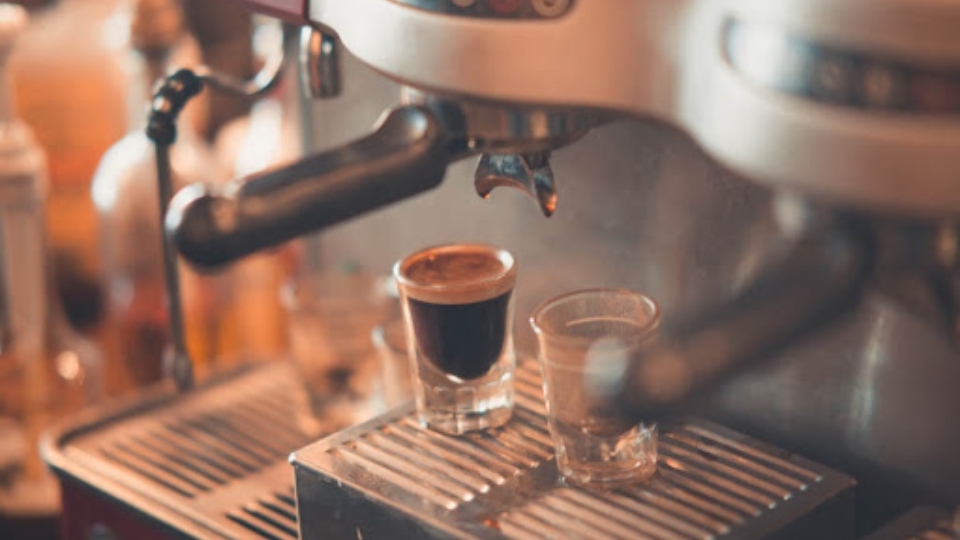
Espresso
Espresso is a rapid infusion brewing method that uses temperature and pressure to speed up the extraction process, giving one of the fastest extraction times on the market. Decent espresso takes skill (and normally training) to create, but it is the basis of the modern cafe industry, with the most common cafe drinks being derived from an espresso shot.
An espresso machine uses a packed filter of fine, freshly ground coffee – through which hot pressurised water is then forced, rapidly extracting the coffee flavour and producing a strong coffee brew with a topping of rich brown foam known as “Crema” – a byproduct of the pressurised water and the CO2 still held within the coffee granules. The entire process generally takes around 20-40 seconds.
Although there are a great many variables at play in the production of espresso, baristas tend to “dial in” many of these factors and have them set to specific values, allowing for a more consistent brewing process. For example, most baristas tend to set their espresso machines to a gauge pressure of 9 bar [17] (approximately 10 times normal atmospheric pressure), and use water at a temperature of around 92°C to 93°C [18], and aim for a coffee-to-water ratio of around 1:2 (yielding a very high proportion of coffee solids in the water, and thus a characteristically strong coffee). Locking in these variables at preferred values means that the barista can modify a few other variables (such as the dose – i.e. the amount of coffee used in the filter), to adjust taste without throwing out the flavour balance of the coffee.
Espresso extraction relies almost entirely on erosion, as the process happens too quickly for the water to diffuse into the lower layers of coffee cells and extract the flavour. For this reason, the grind size used for espresso tends to be very fine – to maximise the surface area available for extraction. But there is also a balancing act where the granules cannot be too finely ground, or the coffee in the bed packs together too tightly to allow the pressurised water to travel through the bed (i.e. in Darcy’s Law terms, the permeability, k, of the bed has been reduced). This generally results in channelling, where the water cuts a path through the ground coffee rather than soaking through the granules and extracting the coffee flavour compounds as it goes.
To avoid this, the barista must take care both with the coarseness of the grind, and with tamping – the process of packing the coffee into the bed before applying water. It is also common to “pre-infuse” the coffee, adding water to the coffee bed at a lower pressure before beginning the extraction process, allowing the pressurised water to more easily diffuse into the coffee bed without channelling (reducing the surface tension).
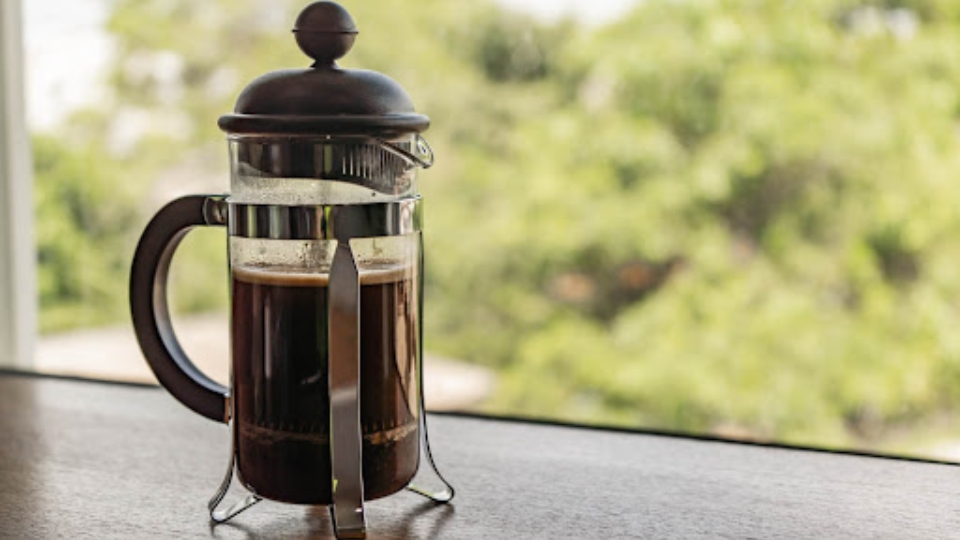
Coffee Plunger / French Press
The French press – also commonly called a coffee plunger – is one of the more common and simpler household methods of brewing coffee. This is an immersion method, where scoops of ground coffee are poured into a glass jug, and then hot water (ideally around 94°C) is added. This brew is then covered with a specialised plunger filter, and brewed for about four minutes. After this, the plunger is pressed down, catching the coffee granules and pushing them to the bottom while the water (and extracted coffee flavour) passes freely through the wire-mesh filter. This coffee liquid is then poured out for drinking.
French press coffee is known for having a distinct rich mouthfeel, as the wire-mesh coffee filter does not absorb oils from the coffee in the way that a paper filter does – meaning more coffee flavour compounds are retained.
Two key variables when using coffee plungers are the water temperature and the coffee-to-water ratio. Temperature is a common factor for home brewers to get wrong, as water is often poured directly from the just-boiled kettle into the plunger, meaning the water is piping hot – close to 100°C. Ideally, french press temperature should be closer to 92°C for optimal extraction, meaning the user should normally wait around 40-60 seconds for the kettle water to cool before adding the water to the plunger. The process is further complicated by the fact that with no additional heat source being applied, the water in the jug will continue to cool as the coffee brews – changing the dynamics of the extraction process.
Coffee to water is also significant, as many coffee plunger jugs don’t have any kind of measurement markings – meaning amounts of water and coffee are often estimated, and thus the strength (or TDS value) of the extracted coffee can vary greatly unless the user measures their quantities carefully (or uses established rules of thumb, such as “five scoops of coffee for a full four-cup plunger”).
Plunger coffee, as an immersion method, can use coarser coffee grinds – as the water has plenty of time to permeate into the coffee granules and extract the flavour – meaning both erosion and diffusion come into play in coffee extraction. However, care should still be taken to make the grind as consistent as possible.
It’s worth noting that the rate of extraction for plunger coffee drops off as the brew progresses. This is due partly to the progressive cooling of the water in the plunger, but also due to the fact that the water becomes progressively more saturated with coffee solids over time [19], meaning the flavour compounds are less prone to dissolve into it (which is common to most immersion methods). This can potentially make plunger coffee a relatively forgiving brewing method, as there is more margin for error before the bitter astringent flavours are extracted from the coffee particles.
Pour Coffee
Pour-over coffee (sometimes known as filter coffee) is one of the simpler types of infusion brewing. Coffee grounds are placed in a filter (normally made of specialised thick paper), which is positioned over a storage jug or coffee cup. Once heated, the hot water is then poured over the coffee (hence the name). Once sufficient water is in the filter, it is left and allowed to permeate through the coffee (pushed by gravity) and filter, extracting the coffee flavour as it goes. The water drips out of the filter and into the vessel below as brewed coffee.
Although the water-to-coffee ratio is potentially a variable factor in pour-over coffee, coffee filters will often use a set measurement of ground coffee and be filled with water to a specific height – keeping the ratio relatively similar. Temperature is a factor, just as with plunger coffee, the optimal temperature for brewing is a few degrees under boiling point [20], meaning the water should be allowed to sit for a while before pouring.

Brew time is effectively out of the brewer’s hands. In the case of pour over, the time required is simply a matter of how long it takes gravity to push the water down through the filter and the ground coffee bed – Darcy’s law in action.
Two of the bigger variables for pour-over coffee are grind size and distribution. Pour over traditionally uses coarse ground coffee. More recently there has been a movement towards finer grinds for pour over coffee, but as a pour-over filter – particularly a conical one – can easily become clogged by fine coffee granules smaller coffee granules, it’s fairly normal to use a medium grind.
Distribution is a particular issue, as the process of pouring the hot water into the filter can very easily agitate the ground coffee in a negative way – either allowing channels to form, or pushing finer particles to the bottom of the filter where they can cause clogging. Experts of pour over coffee often have specialised equipment – such as a gooseneck kettle (with a long, thin neck) – and specific pouring methods. Pour over coffee also often benefits from pre-wetting (aka pre-infusion).
Drip Filter
The drip filter coffee machine is a percolation brewing method that is effectively the automated equivalent of pour over coffee. Once again, hot water is added to a filter loaded with ground coffee (often pre-wetted to allow the water to permeate the coffee more easily). But in this case, the process is automated, with the machine heating the water and then allowing it to drip into the coffee granules. The water then passes through the ground coffee, extracting flavour as it goes, and flows through the filter to drip down into the coffee jug below.
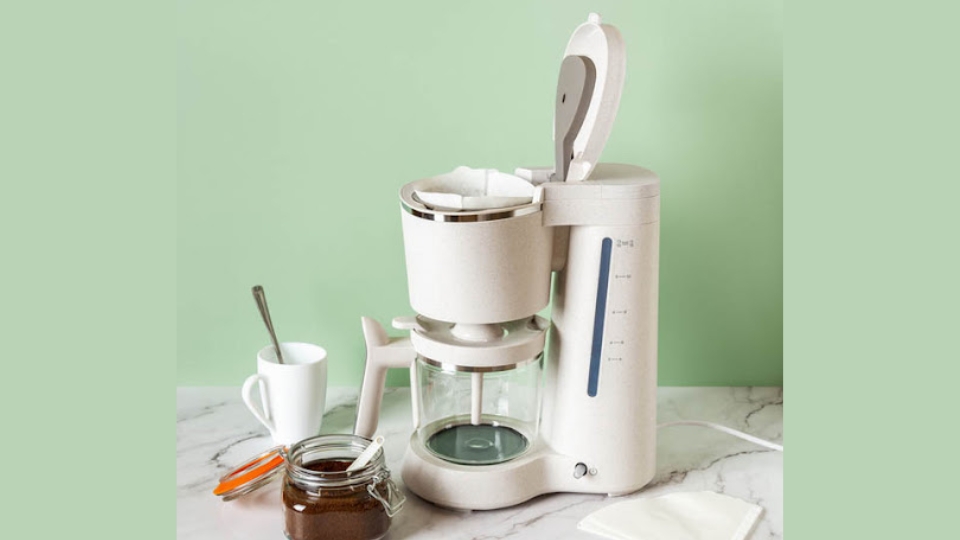
Granule distribution is far less of an issue with drip filter than it is with pour-over coffee. It is still significant when preparing the filter, but individual drips of coffee from a drip filter machine are far less likely to disrupt a coffee bed than water poured from a kettle spout. Pressure is constant throughout the process – the water is not pressurised when passing through the filter, meaning the water flow is entirely gravity driven. And just like pour over coffee, the time the water is exposed to the beans is purely down to the time the water takes to flow or percolate down through the filter and into the jug below – a function of the resistance provided by the coffee bed and the force of gravity driving the water down.
The water temperature is also set by the machine. This can often be configured by the user. But once the coffee is brewing, regulation of water temperature is out of the user’s hands – it’s something that’s normally dialled in to a desired level and then left constant. The dose is also theoretically adjustable, but most drip filter coffee machines will have a system of measured ground coffee scoops or something similar to provide a consistent coffee-to-water ratio.
Practically speaking, this makes filter coffee one of the more hands-off brewing processes – the user simply fills the filter (trying to ensure an even distribution), and then sets the machine going – which is exactly what it was designed for. The only real variables left to the user once the machine is configured are the size of grind that you use (normally medium), and the way the filter is filled (aiming for an even distribution). Besides these initial factors, drip filter coffee is designed to be set and forget.
Cold Brew Coffee
Cold brew is mechanically similar to French press or plunger coffee in that it’s an immersion brewing method where the water and ground coffee are combined and then left to steep so the water can extract the flavour compounds from the coffee granules via diffusion. The primary difference is that the water used in cold brewing – as the name implies – is room temperature or lower.
Just as using hot water (and pressure) speeds up coffee flavour extraction, the use of cold water greatly slows down the extraction process – meaning that cold brew coffee normally takes around 18-24 hours to extract properly. It’s also significant that the cold water slows down the extraction of some flavour compounds more than others – notably the extraction of the bitter, astringent flavours associated with over-extraction.
This means that the margin for error when extracting coffee flavour is very high. As such, despite cold brewing being a very slow process, the result of that time investment is brewed coffee with a characteristically smooth, balanced flavour. Cold brew is often drunk cold, although it can be heated in the microwave.
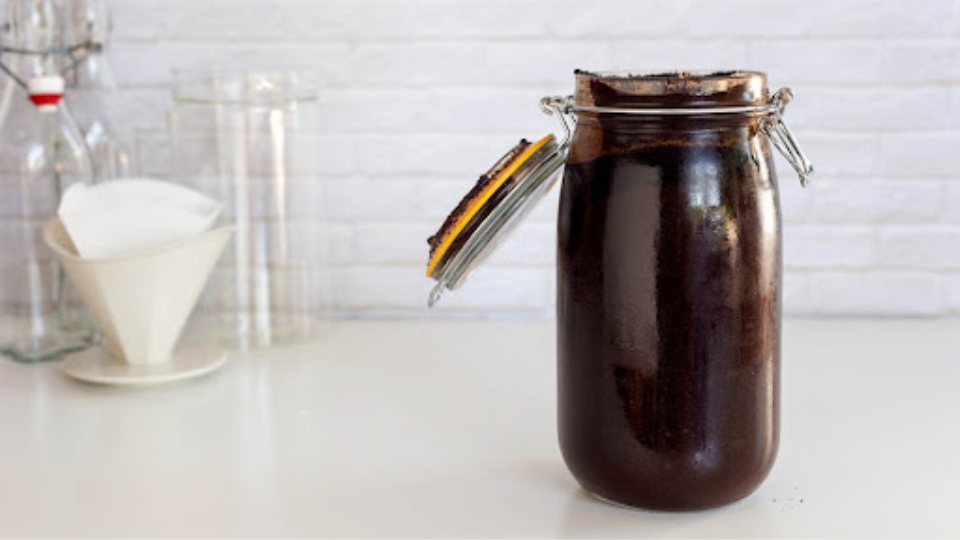
Cold brew can be made ready-to-drink – so effectively it can be heated and drunk like regular coffee – with a coffee-to-water ratio of around 1:15. But it is also common for cold brew coffee to be made as a concentrate [21], with a ratio of between 1:5 and 1:8. This can be diluted for use like regular coffee, mixed with milk, or even used in cocktails or cooking.
So while cold brew coffee uses a similar brewing method to plunger coffee, the differences in water temperature, brewing time, and often coffee-to-water ratio yield a rather different flavour profile.
Cold Drip Coffee
As cold brew is the cold equivalent of methods such as French Press, cold drip is the room-temperature equivalent of drip filter coffee – an infusion method using cold water over a far longer time arc. Rather than using a machine (as the water does not need heating), a cold drip brewing setup is often an aesthetically pleasing tower of three glass vessels. Cold water is added to the top vessel (often with ice), which drips slowly into the middle beaker. The dripper often features a tap, allowing the drip rate to be adjusted as needed.
This water then drips into the middle vessel, which serves as the filter where the ground coffee is held. The water then slowly permeates through the filter and drips into the final vessel at the bottom, where the brewed coffee is collected.
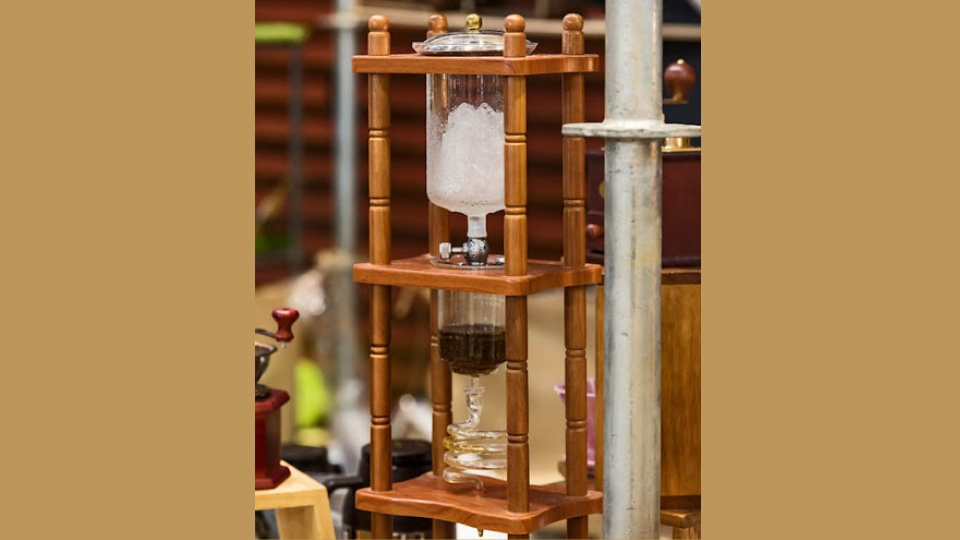
Cold drip coffee is often made as a concentrate (as with cold brew), with a coffee-to-water ratio of around 1:6 to 1:8. This can vary according to preference. The time taken for brewing can vary depending on the water drip rate the apparatus is set to, but it is often quicker than cold brew – often between 3 and 12 hours, although it can be over the course of 24 hours for a more intense brew.
Effectively, despite using different-looking apparatus, cold brew is mechanically very similar to drip filter coffee.
Moka Pot
The moka pot was invented in the 1930s by an Italian engineer, and has become one of the standards for household coffee production throughout the world. Many people would recognise the classic shiny octagonal aluminium jug, even if they’d never used one themselves. The moka pot is percolation method with some similarities with espresso – and is sometimes thought of as the easy home brewer’s equivalent of espresso brewing.
The three-part pot features a water jug at the bottom, a coffee filter section in the middle where the ground coffee is placed, and a coffee jug at the top where the brewed coffee collects. The pot is placed on the stove, causing the water in the bottom vessel to heat up. As the water turns to steam in the lower vessel and the air heats up and expands, this creates pressure that pushes down on the hot water and forces it up through the connecting tube (the opening of which is at the bottom of the water jug), through the ground coffee, and up into the coffee jug at the top as brewed coffee. This comes out as a strong brew, around half the concentration of espresso but still far stronger than filter or French press coffee.
Like espresso, the moka pot uses pressure to force water through a bed of coffee, although in this case, the water is being pushed upwards, meaning gravity is actually working against the pressure pushing the water through the coffee rather than with it. The pressure involved is considerably less than espresso, at around 1.5 bar [22]. That’s less than the water pressure in your taps (normally around 3-4 bars) and a lot less than the 9 bars normally used in espresso. But it’s still enough to push the water up through the coffee grinds. It does mean a moka pot is slower than espresso, though, normally taking around 5 minutes for the brewing process.

Although coffee to water ratio is a variable for the Moka pot, this is relatively easy to regulate as you can use the same quantities each time – many jugs even have “fill to” lines inside. The coarseness of the grind should generally be medium fine to fine (not quite as fine as espresso). Distribution is also important, as it is with espresso. Care should be taken when preparing the coffee not to grind too finely or pack the coffee too densely or unevenly into the filter as in addition to the normal risk of clogging and poor extraction, there is a very small chance that a clogged moka-pot could explode.
Talking about brewing time as a variable here is slightly complex. In some ways, the moka pot is set and forget – you put it on the stove and wait. The speed of the process is entirely defined by the pressure in the pot pushing the water through the system. However, there are a number of factors that can affect this. For one, there is much discussion about whether water should be preheated for a moka pot. Some prefer room temperature for a slower brewing process. Some lean towards adding the water to the pot at around 70°C. It’s also important to note that a moka pot has a turning point where it must be immediately removed from the stove. This occurs when the water level in the bottom jug has dropped far enough that steam can now escape up into the coffee filter. When this happens you need to take the pot off the stove, as the hot steam will cause the coffee to over extract rapidly and taste bitter.
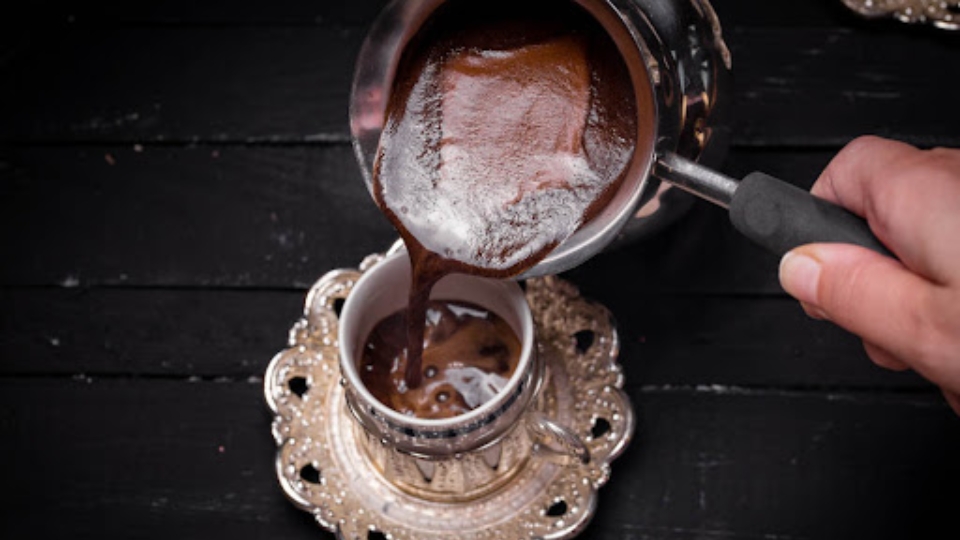
Turkish coffee
Turkish coffee is an unusual and distinctive immersion brewing method, where no attempt is made to filter the coffee granules out of the solution – they’re left in and served with the drink. The coffee is ground exceptionally fine, and then both ground coffee and water are simply added to a cezve (a long-handled pot) and heated over a fire or hotplate. When poured into cups, some of the coffee granules settle to the bottom of the cup, but much remains in the solution and is drunk with the coffee.
Because Turkish coffee doesn’t extract the ground coffee from the brew at all, it often tends towards over-extraction and is characteristically bitter in flavour. Many of the variables that normally apply to brewing coffee simply don’t apply here. Pressure is always equal to ambient atmospheric pressure. As an immersion method, grind distribution isn’t significant. And grind size is fairly constant – Turkish coffee is ground as fine as possible, even finer than espresso.
The main variables at play are temperature, brewing time, and coffee-to-water ratio. 1:9 is a fairly standard coffee-to-water ratio for turkish coffee, but others may prefer 1:12. Those that are keen to limit the bitterness of Turkish coffee might heat the coffee carefully, (keeping it under 70°C) and serve it within a few minutes – meaning some of the more bitter flavour compounds have not yet been released. Others embrace the bitterness, often serving the coffee heavily sugared and with a sweet treat like Turkish delight to compliment it.
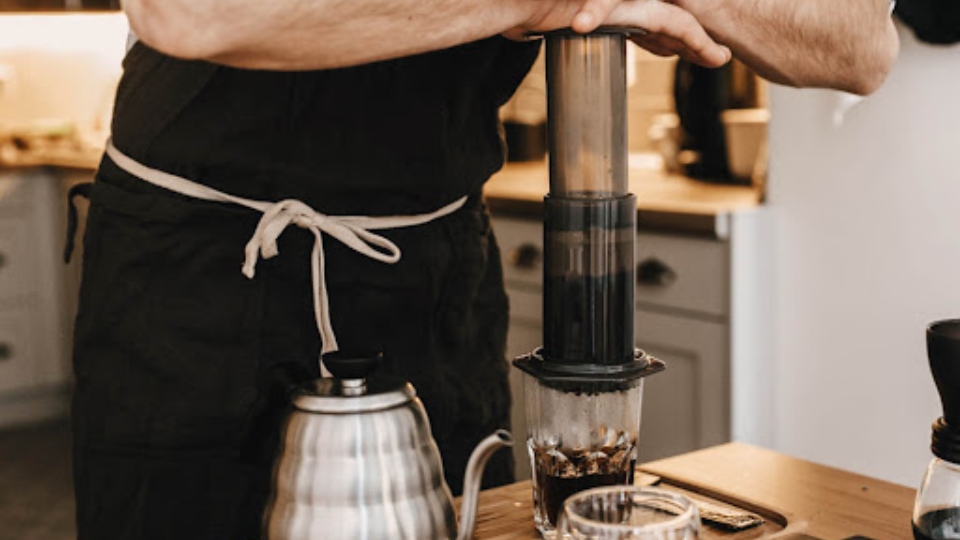
Aeropress
The AeroPress coffee maker is quite a recent innovation, designed in 2004 by a lecturer in mechanical engineering (the same man who designed the Aerobie frisbee). The AeroPress is unusual, given that it may be used either for immersion or infusion brewing.
The Aeropress is a simple but clever device – a plastic cylinder with a screw-on coffee filter (including a disposable filter paper) on one end and a plunger with a rubber seal on the other. Used as originally intended, the aeropress was designed for infusion brewing – designed to be placed filter-down on a coffee cup or jug, have coffee poured in the other end, water added on top, and then then the plunger inserted and pressed gently down. This slightly pressurises the air inside the cylinder and pushes the coffee down through the coffee bed and filter, and into the cup.
Clever coffee fans have also figured out that if the plunger is added first and the device is inverted, the coffee and water can be added to the open cylinder and allowed to brew by immersion. Then the filter is screwed on, and the device is inverted, allowing someone to push the now mostly brewed coffee down through the filter and into the mug.
Despite the Aeropress being a relatively simple device, most of the variables that affect brewing are in play here. The plunger creates pressure in the cylinder to push the water through the coffee, and the inventer encourages brewers not to push too hard on the plunger (in some of his “how to” videos) for fear the coffee might become compacted slow down the brewing process. Water temperature is also a matter of user choice, with temperature as low as 80°C being an option. Distribution is significant – the user generally needs to shake the cylinder to distribute the coffee more easily and then agitate the coffee with a stirrer once the water has been introduced.
Grind size, brew time and the amount of coffee and water (and thus the coffee-to-water ratio) have recommended values, but there is considerable flexibility for a user to experiment with those values – or potentially get them wrong by accident.
The Aeropress is one of the more versatile brewing methods, where almost every factor of the brewing process can be changed – including whether it’s an immersion or infusion method. This means seasoned coffee brewers have enormous flexibility to adjust for taste. On the downside, this means the potential for error with new users is quite high. Because of this, it’s probably wise for less experienced brewers to stick to the instructions and recommended ratios, and perhaps just try changing one variable at a time.
|
Brewing Method |
Pressure (Bars) (Gauge Pressure) | Optimal Water Temp | Grind Size | Extraction Time | Coffee / Water Ratio |
Mechanism |
| Espresso | 9 | 92°C – 96°C | Fine | 20-40 Seconds | 1:2 | Percolation |
| French Press | 0 | 90°C – 95°C | Coarse | 4-5 Minutes | 1:12 – 1:15 | Immersion |
| Pour Over | 0 | 90°C – 96°C | Medium | 3-4 Minutes | 1:15 – 1:17 | Percolation |
| Drip Filter | 0 | 90°C – 96°C | Medium-Coarse | 4-5 Minutes | 1:15 – 1:17 | Percolation |
| Cold Brew | 0 | Room Temperature / 2°C – 4°C | Medium-Coarse | 18-24 Hours | 1:5 – 1:8 (for concentrate) | Immersion |
| Cold Drip | 0 | Room Temperature | Medium-Coarse | 3-12 Hours | 1:6 – 1:8 (for concentrate) | Percolation |
| Moka Pot | 1.5 | 30°C – 40°C (Initial Temp.) | Medium-Fine | 4-5 Minutes | 1:7 – 1:8 (espresso style) | Percolation |
| Turkish Coffee | 0 | 60°C – 70°C | Ultra fine | 3-4 Minutes | 1:9 | Immersion |
| Aeropress | 1.25 – 1.5 | 80°C – 85°C | Varies | 2-3 Minutes | 1:6 or 1:16 (varies) | Can be either |
Conclusion
Coffee is an incredibly complex beverage. There are thousands of flavour compounds involved, dozens of different brewing methods available, and countless individual factors subtly influencing the taste along the way – from the way the beans are harvested to whether the kettle is left to sit after boiling. Realistically, getting a great coffee flavour is far more of an art than a science. But by understanding some of the factors that influence the brewing process, why they’re important, and how they might contribute to the final flavour, we can greatly improve our odds of getting a reliably good cup.
References
- Coffee extraction kinetics in a well mixed system – https://mathematicsinindustry.springeropen.com/articles/10.1186/s13362-016-0024-6
- What Affects Brew Time – https://coffeeadastra.com/2019/10/20/what-affects-brew-time/
- The Arrhenius equation – https://www.britannica.com/science/Arrhenius-equation
- The perfect cup of coffee boils down to four factors – https://theconversation.com/the-perfect-cup-of-coffee-boils-down-to-four-factors-30208
- Analysis of Volatile Compounds in Coffee Prepared by Various Brewing and Roasting Methods – https://www.ncbi.nlm.nih.gov/pmc/articles/PMC8230519/
- Systematically Improving Espresso: Insights from Mathematical Modeling and Experiment – https://www.cell.com/matter/fulltext/S2590-2385(19)30410-2
- How to Measure Extraction of Coffee? – https://www.baristainstitute.com/blog/jori-korhonen/january-2019/how-measure-extraction-coffee
- How To Make Turkish Coffee – https://www.artisanlapetite.com/blogs/news/how-to-make-turkish-coffee
- The Dynamics of Coffee Extraction – https://coffeeadastra.com/2019/01/29/the-dynamics-of-coffee-extraction/
- Coffee Degassing; What Does It Mean For Brewers & Roasters? – https://perfectdailygrind.com/2019/01/why-does-coffee-degas-what-does-it-mean-for-brewers-roasters/
- The Science of a Perfect Cup of Coffee – https://www.scientificamerican.com/article/the-science-of-a-perfect-cup-of-coffee/
- Is Pre-Ground Coffee Ever Better Than Freshly Ground? – https://perfectdailygrind.com/2018/12/is-pre-ground-coffee-ever-better-than-freshly-ground/
- How Long Does Ground Coffee Last? Does It Go Bad? – https://www.doesitgobad.com/does-ground-coffee-go-bad/
- Infusion, Immersion, Percolation, and Decoction Coffee Brewing – https://goodcoffeeplace.com/immersion-verses-infusion-coffee-brewing/
- Fines: Fine for Espresso, Not So Fine For Filter – https://www.scottrao.com/blog/2017/8/27/fines-fine-for-espresso-not-so-fine-for-filter
- Why do Percolation and Immersion Coffee Taste so Different? – https://coffeeadastra.com/2019/07/16/why-do-percolation-and-immersion-coffee-taste-so-different/
- What is the ideal pressure for espresso? – https://www.sevenmiles.com.au/blogs/editorial/espresso-pressure
- How to analyse coffee extraction – https://www.beanscenemag.com.au/how-to-analyse-coffee-extraction/
- Coffee Extraction & Other Key Brewing Concepts – https://perfectdailygrind.com/2017/06/understanding-coffee-extraction-other-key-brewing-concepts/
- What is the Perfect Temperature for Pour Over Coffee? – https://easyhomecoffee.com/pour-over-coffee-brew-temperature/
- How to make Cold Brew Coffee (the ultimate guide) – https://www.sevenmiles.com.au/blogs/editorial/cold-brew-coffee-guide
- How do moka pots work? – https://www.howitworksdaily.com/how-do-moka-pots-work/
About the Author:

Lochy Cupit
Author, Content Writer, Storyteller and Wordsmith
Lochy Cupit is a published author, professional content writer, content researcher, multimedia & web developer, youth worker, actor, radio presenter, podcaster, and creative arts specialist. He currently works as a content writer for a professional first aid training organisation. He holds bachelor’s degrees in computer science and multimedia, a masters in creative writing, and a graduate diploma in theology – because “why study just one thing”? He lives in Adelaide with his wife and two highly energetic boys.
Facts Checked By:
Dr. Richard Muhlack thoroughly reviewed this research and provided positive feedback on its quality. He carefully examined the research, and confirmed the accuracy of the information. Dr. Muhlack holds a PhD in Chemical Engineering and has acquired over twenty years of experience in the wine industry through various research and industry roles. His expertise spans across a diverse range of areas including process analysis and simulation, cleaner production, energy efficiency, renewable energy technology, waste treatment, and environmental management.
